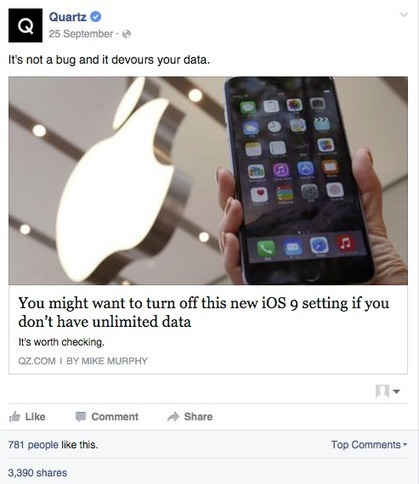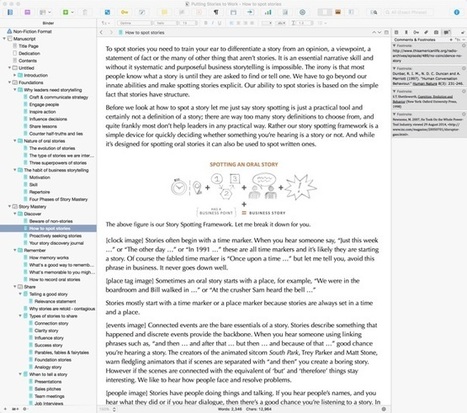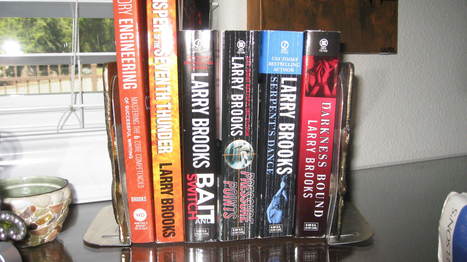 Your new post is loading...
 Your new post is loading...
The results make for interesting reading. Reagan and co say that their techniques all point to the existence of six basic emotional arcs that form the building blocks of more complex stories. They are also able to identify the stories that are the best examples of each arc. The six basic emotional arcs are these:A steady, ongoing rise in emotional valence, as in a rags-to-riches story such as Alice’s Adventures Underground by Lewis Carroll. A steady ongoing fall in emotional valence, as in a tragedy such as Romeo and Juliet. A fall then a rise, such as the man-in-a-hole story, discussed by Vonnegut. A rise then a fall, such as the Greek myth of Icarus. Rise-fall-rise, such as Cinderella. Fall-rise-fall, such as Oedipus. Finally, the team looks at the correlation between the emotional arc and the number of story downloads to see which types of arc are most popular. It turns out the most popular are stories that follow the Icarus and Oedipus arcs and stories that follow more complex arcs that use the basic building blocks in sequence. In particular, the team says the most popular are stories involving two sequential man-in-hole arcs and a Cinderella arc followed by a tragedy....
"The great writer's gift to a reader is to make him a better writer." “Stories,” Neil Gaiman asserted in his wonderful lecture on what makes stories last, “are genuinely symbiotic organisms that we live with, that allow human beings to advance.” But what is the natural selection of these organisms — what makes the ones that endure fit for survival? What, in other words, makes a great story?
Via Mary Daniels Brown
For the most part, just planning to go viral is not a viable social strategy for publishers. Instead, they should be thinking carefully about how each piece of content they produce has the potential to be shared on different platforms and devices. That means having good site infrastructure, facilitating sharing, and serving up the right sort of stories at the right time. Most of all, it means telling great stories that the readers of your site can relate to and pass on to the rest of their network.
But it’s easier said than done for many publishers. Being able to present a story for a social audience is often a bigger challenge than presenting it on your homepage. There, readers have arrived looking to click and read your stories alone, in the news feed, you’re just another box demanding their attention.
Here are three recent examples of publishers employing good editorial filter on social. All of these stories did well for their sites: they got shared and commented on lots, they were well-presented on different platforms and devices, and most importantly, they spoke to their target audience, and their friends and followers....
On Twitter, Pixar storyboard artist Emma Coats has compiled nuggets of narrative wisdom she's received working for the animation studio over the years. It's some sage stuff, although there's nothing here about defending yourself from your childhood toys when they inevitably come to life with murder in their hearts. A truly glaring ommission.
#1: You admire a character for trying more than for their successes.
#2: You gotta keep in mind what's interesting to you as an audience, not what's fun to do as a writer. They can be v. different....
This is a tale of memory, truth, technology, and, well, the future of humanity—but it starts in high school.
If you went to high school in America, there is a pretty good chance you learned to write essays using the dreaded five paragraph method. For those who don’t remember, the structure is this: Introductory paragraph (wherein you lay out your thesis), followed by three supporting graphs (each one making a different yet complimentary supporting argument), finished with a conclusion (essentially your introduction restated and a final conclusion drawn).
What I want to point out here is the amount of data being offered up. While it’s called a five paragraph essay, the argument itself hinges on three main data points. Three core ideas. Because of this, the five paragraph essay is also known as the “hamburger essay” or “one, three, one,” or, occasionally, a “three-tier essay.”...
Once upon the time--1969, to be exact--The Valley of Gwangi (see poster, left) was made. Based on a story concept by stop-motion pioneer Willis O'Brien (King Kong), and employing the stop-motion effects of Ray Harryhausen (former apprentice to O'Brien), it was and is the greatest cowboy-dinosaur movie ever made.
In the summer of 1970, a pencil-necked geek named Matt (see photo, right) discovered Gwangi quite by accident when it was the opening "B-movie" at his local theater with When Dinosaurs Ruled the Earth. Matt was all of seven, and he hooted and hollered and cheered throughout the film.
He was all alone that evening ... well, sort of all alone....
Nobody turns B-movies into high art like Robert Rodriguez. With the launch of his latest Machete Kills he breaks down his process.
Storytelling is absolutely essential whether it be traditional paid media, owned media like social networks and blogs, or earned media where someone else is telling your story. It’s critical to connect your story of how you solve the customer’s problems at each step of their journey. The key in storytelling though is to recognize that people are going to enter your story at different chapters and pages along their journey. It’s Their Story, Not Yours So as you think of telling your story you must visualize it through their eyes. You should ask, where is the customer in the buying cycle, where are they in the learning cycle, and how does it relate to their job’s role as it relates to that stage of the process? That way the story is relevant to their needs, their issues, their requirements....
Writing a good blog post isn’t just about great content… Writing truly engaging and exciting blog posts and marketing is an art for that involves storytelling, emotion, and creating an immersive experience for your readers. How you structure your marketing techniques in terms of storytelling, and connecting with readers, can often leave more of an impact than the content itself (think about how a song or story touched you more because of the emotional impact than the details of the story itself). In this post I want to share 3 tips you can use to enhance the appeal of any post you write, and make it incredibly engaging to your readers....
1. Stories are about people. Even if your organization (a) is devoted to saving flora and/or fauna, (b) toils in the dense thicket of policy change, or (c) helps other organizations work more effectively, human beings are still driving the action. So your protagonist has to be a person. And since this person also serves as the audience’s guide through the story, it’s essential to provide some physical description when he or she is introduced. This helps your audience form a mental picture—after all, it’s hard to follow what you can’t see. And don’t forget to include your characters’ names. Audiences will relate more readily to “Marcus” than “the at-risk youth,” even if you have to use a pseudonym to protect your subject’s identity.....
I am a big fan of The New York Times Dining section. Donut drama. Importing Mom instead of the pasta. Hunting for “treasures” in restaurant laundry. And the list goes on. The NYT Dining journalists know how to shape story lines beyond the – “chef showed restraint, allowing the flavor of the fresh [fill in the blank] to take center stage” – and do it with clever wordsmithing. Peter Wells’ review of a Guy Fieri restaurant last week is right up there with the best. The fact that the piece triggered more than 1,000 comments (not a typo) shows I’m not the only person who noticed.... [Great writing, technique and de3vastating review and PR crisis for NY restaurant ~ Jeff]
Storytelling is a powerful approach that can, when done right, compel users to convert more effectively than what any amount of optimization, crazy visual callouts, or awesome interactive elements can do otherwise. Much like how we expect to see a moral at the end of a book, we expect to find a purpose at the end of a site with a storytelling experience. When the path to the “moral of the story” (or conversion point, to be more specific) is laid out clearly in front of our users’ eyes, the rest of the work lies simply in convincing them that the purpose is really worth grabbing on to… which is great since with storytelling, a user is normally in the mindset of learning more about what the story has to offer. So take a look at the examples below and experience how their visual storytelling compels you to continue scrolling down their pages!... [30 very inspiring examples of storytelling online for bloggers, writers and content pros. Just dive in! ~ Jeff]
Malcolm Gladwell, Daniel H. Pink, David Sedaris and others search for highly-intelligent life in the universe. The MacArthur Geniuses were announced this week, which got us wondering about genius. What is genius? Can it actually be measured? Is it even a real thing? [This is genius writing, selected and shared by Byliner. If you've never tried Byliner, you're in for a treat. It's like having your own literary salon. Well worth the mostly-free subscription ~Jeff]
|
I’m often asked how I wrote Putting Stories to Work. People want to know about the writing process and how I did the research. I had similar questions before I started including, How many words do I need to write? How many chapters should it be? What’s the best word processor? So in this post I want to share with you what I learned.
First let me describe the type of book I wanted to write. First and foremost it was important the book was replete with stories. It’s a capital offence to talk about storytelling and not tell a story. I also wanted it to be a practical book, a bit like David Allen’s How to Get Things Done. It was important that it was research based. I didn’t want to just say, for example, that stories are memorable without pointing to research that backs up my statement. I also wanted to share this research as stories of the experiments. This meant I was on the hunt for experimental research rather than theories. I read a lot of business books and I was inspired by Adam Grant, Malcolm Gladwell, Dan Pink and the Heath brothers, to name a few.
Last year I did a post for the Writers Digest website, explaining why (my opinion) “just write” is among the most dangerous soundbytes of writing advice ever uttered. It’s like telling someone about to on trial without a lawyer (an apropos analogy to trying to write a story without knowing how to write a novel) to skip law school and “just talk.” One reader commented in response that, because after years of practice some writers can indeed “just write” and be successful… I thank her for helping make my point.
There is a huge, hard-won backlog of knowledge and principle that makes anything that can otherwise be “made up as you go along” functional, if not downright fatal.
“Just do it” can get you killed, and it can kill your story, as well.
In that context, I’ve yet to encounter a writer who can disprove the existence or need for a largely given structure – the order and context for how a story should flow – for the rendering of long form storytelling....
I like to ask people when I meet them, “What’s your story?”
It’s more interesting to me than typical questions about education, major, city of origin, job title, or sports team. All of these things might play a part in their story, but story implies something much broader and more personal. It’s the narrative of your past, present, and expected future. It’s the drama of your own life as you see it playing out.
When I think of the most interesting and talented people I know, I think of their story. I don’t think of their status. “Oh, he’s a graduate student” is a status. So is, “Married, salesperson, lives in Ohio”, or, “Studying business at USC”. A status is a static snapshot of a handful of labels attached to a person based on some institutions or external standards. It conveys nothing really unique that gets to the core of the person, or the animating force behind their actions and ideas. There is no passion in it. No sense of direction and creativity....
For the past several weeks, Thursday mornings have taken on a special meaning for hundreds of thousands of curious souls around the world. That's when the the makers of the podcast Serial release the latest installment of the weekly show. You'll know the new one has arrived when your Twitter timeline begins to look like aSerialword cloud.
The true crime narrative show debuted earlier this fall to instant acclaim, and it has only gained in popularity each week--taking the top spot on iTunes, inspiring memes and Reddit sleuthing, and spawning bookshop listening parties and the like. While the subject of Serial is indeed a juicy whodunit, there's no mystery about just why people are mainlining episodes with such rabid intensity: this is seriously compelling storytelling....
About six months ago, Pocket Gems, a mobile game developer, launched a new platform called Episode. It allows writers to script a story and then turn it into an animated interactive mobile story. It combines parts of TV shows, comics, and novels, and provides the unique ability for readers to have some control of how the story goes.
I started writing on the platform almost as soon as it launched and have written three stories to date. My most successful story, Finding Mr. Wright, has built a significant audience in a short time. So far it has an audience of 163,000 readers, who have collectively read over 1,222,000 chapters of my story....
Three unpublished stories by the famously reclusive American writer, J.D. Salinger, have leaked online after appearing on an eBay auction.The auction, which ended Sep. 23, 2013, advertised a book containing three stories, titled "Untitled or Paula," "Birthday Boy," and "The Ocean Full of Bowling Balls". The first two stories are dated 1941 and 1946, respectively, while the third one doesn't have a date....
Since launching in private beta last year, Medium has been building up its platform, which aims to offer a simple but 'beautiful' reading and writing experienceIt was one year ago this week when the online publishing world was abuzz with the news that two of Twitter's founders had launched a new platform called Medium, in private beta.In the early days only a select group of people were allowed behind the scenes to contribute content to Medium.
Some details on the platform were made public via an announcement post from Ev Williams, in which he described Medium as "a new place on the Internet where people share ideas and stories that are longer than 140 characters and not just for friends".In the past year the group of people invited to write has grown, and we are told it "should be a short wait from now" when the platform will be available for all to use.
The main aim of Medium is to be "the best place to read and write about things that matter", and this emphasis on both the writing and reading experience has been reflected in its approach over the past 12 months....
Trend-setter, impresario, phenomenon: David Bowie has shaped entire subcultures. Jon Savage traces the star's talent for reinvention and his catalytic encounter with William Burroughs...
In April 2011, Kelley Benham gave birth four months early. Her daughter Juniper’s birth was supposed to be a joyous occasion. Instead, it was marked by physical and emotional pain, shock, and uncertainty about whether the micro preemie, who weighed just 1 pound 4 ounces, would survive. Benham and her husband, journalist Tom French, were faced with a pivotal question: Fight for their daughter’s life or let her go? In a recent three-part series in Poynter’s Tampa Bay Times, Benham wrote about how she and French confronted this question and how the answer they sought has changed their lives. “A story is a promise,” French said to her as they read to Juniper. “It’s a promise that the end is worth waiting for.”...
Benham and her husband, journalist Tom French, were faced with a pivotal question: Fight for their daughter’s life or let her go? In a recent three-part series in Poynter’s Tampa Bay Times, Benham wrote about how she and French confronted this question and how the answer they sought has changed their lives. “A story is a promise,” French said to her as they read to Juniper. “It’s a promise that the end is worth waiting for.”
Geoff Livingston: "Stories told across multi-platform media environments — or transmedia stories as they are commonly called on the edge — require more complex writing. A story unfolds across diverse media with readers/viewers opting in to each layer." [Excellent look at the challenge of writing for Transmedia ~ Jeff]
Via The Digital Rocking Chair
Pippa Davies shares a really useful guide to help you find blogging, storytelling and PR writing ideas. Her CSI-styled examples include: - turn the evidence upside down - ask what if? - find the backstory - zoom in on what's important - build your evidence - scout different locations - comb the scene for new evidence All in all, great tips and a fun read. ~ Jeff
Via Barb Lack
|



 Your new post is loading...
Your new post is loading...





































Scientists at the Computational Story Laboratory have analyzed novels to identify the building blocks of all stories.